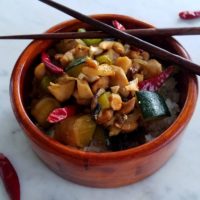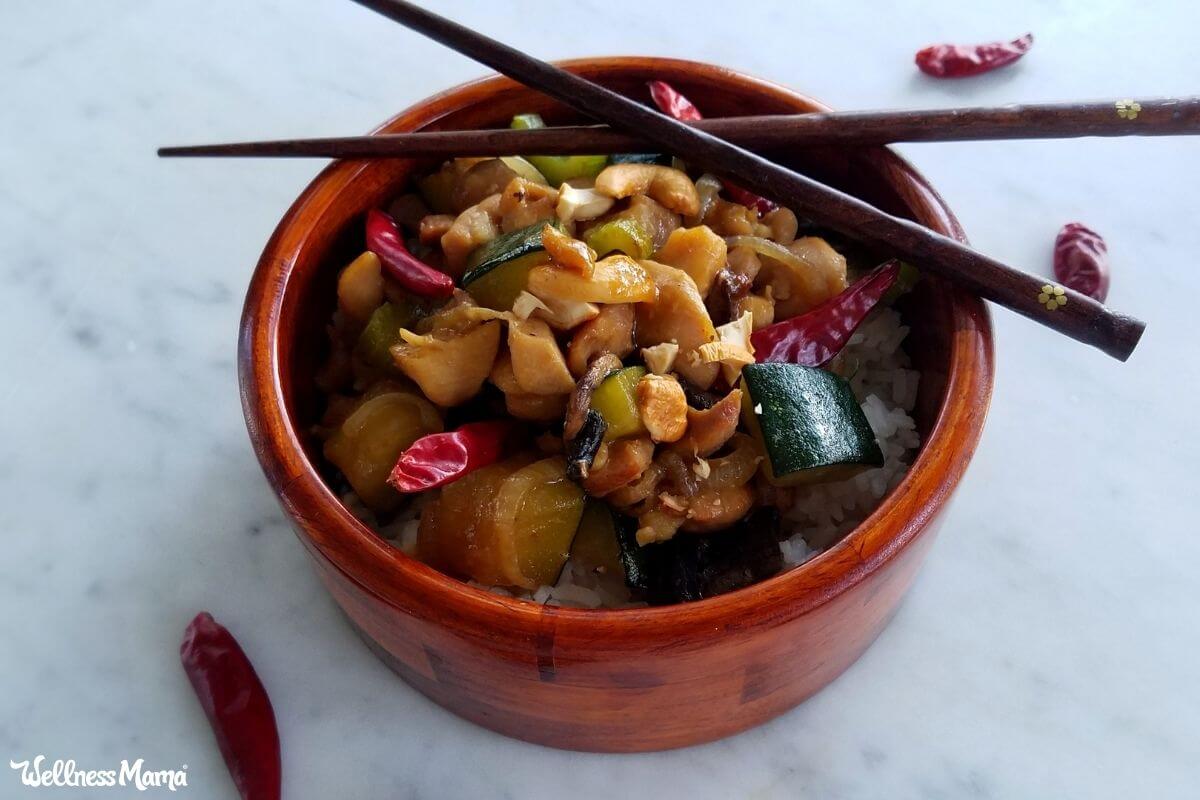My love of Chinese food isn’t a new thing nor is my hobby of recreating favorite restaurant Chinese dishes at home. Sweet and sour chicken was one of my first recreation attempts. This kung pao recipe is the most recent, and absolutely delicious.
Traditional Kung Pao Chicken
Kung pao chicken is a Chinese stir-fry dish of chicken, leeks, peanuts in a spicy sauce. If you order it at a Chinese restaurant you’ll probably see little dried red chile peppers in it. It’s usually quite a spicy dish. (The dried chile peppers are just for flavoring the dish — don’t eat them!)
My family likes a little heat, but if yours doesn’t you can easily adjust the spiciness level. When I make it, I use both the little dried red chile peppers and red pepper flakes. That’s because the batch of chile peppers that I currently have isn’t very spicy.
You can use both too, or just use either one or the other, in whatever amounts you like best. I suggest adding just a little and tasting it after it’s done. You can always add more heat, but you can’t really take it back out again. Once you know what amount works for you, you can use that amount from then on out.
Side note: If you want to learn more about little dried red chile peppers (and other spices) used in Chinese cooking this glossary is really interesting.
Paleo Kung Pao Chicken, the Wellness Mama Way
I love the flavors of Chinese restaurant kung pao chicken, so I of course wanted to find a way to make it myself with ingredients that I’m comfortable feeding my family.
- For the sauce I swap out the cornstarch for arrowroot, the soy sauce for coconut aminos, and the sugar for honey.
- For the chicken I usually use quality boneless, skinless thighs because I love how tender and flavorful they are, but I’m not against using diced breasts when it’s what I have on hand.
- I prefer tree nuts over legumes for the most part so I substitute the peanuts with chopped cashews.
- The vegetables I use vary from one preparation to the next. I love that in stir-frys you can use whatever is in season or you have on hand. I’ve used leeks, celery, bell pepper, onion, zucchini, and even okra.
- I serve it all by itself or over cauliflower rice or occasionally, white rice.
Other Healthy Asian/Chinese Food Recipes
- Spicy Shrimp Stir-Fry With Peppers
- Asian Lettuce Wraps (like P.F. Chang)
- Quick Chicken and Rice Oyakodon Bowl
- Easy Yum Yum Sauce Recipe
- Chinese Chicken Stir-Fry (Quick and Healthy)
- Bulgogi: Korean Beef Recipe

Paleo Kung Pao Chicken Recipe
Servings
Ingredients
- 2 lbs boneless skinless chicken thighs
- ½ tsp salt
- ¼ tsp black pepper
- 2 TBSP coconut oil (divided)
- 4 cups vegetables (such as celery, broccoli, onion, bell pepper)
- ¾ cup cashews (chopped)
Sauce Ingredients
- 1 TBSP arrowroot powder
- 2 TBSP honey
- ¼ cup coconut aminos
- 3 TBSP Shaoxing cooking wine (or cooking sherry, or chicken broth)
- 2 TBSP rice vinegar (or apple cider vinegar)
- ¾ cup chicken broth
- 1 TBSP sesame oil
- 4 cloves garlic (minced)
- 1 tsp dried ginger (or 1½ TBSP fresh ginger, grated)
- 1 tsp red pepper flakes (or more, or less depending on your love of heat)
- 6 dried red chili peppers (optional)
Instructions
- Chop the chicken into bite-size pieces and season with salt and pepper.
- In a large pan, heat 1 tablespoon of the coconut oil over medium-high heat.
- Add the chicken and sauté until it is cooked through.
- While the chicken is cooking, chop desired vegetables into bite-size pieces.
- Remove the chicken from the pan to a bowl, and set aside.
- Add the remaining tablespoon of coconut oil and the chopped vegetables to the pan.
- Sauté until crisp-tender, stirring occasionally.
- While the vegetables are cooking, whisk together in a medium bowl all ingredients for the sauce.
- When the vegetables are done, return the chicken to the pan with the vegetables and pour in the sauce.
- Reduce the heat and bring to a gentle simmer for about 5 minutes.
- To serve, eat as is or over cauliflower or white rice. Top with chopped cashews.
Nutrition
Notes
Do you like spicy food? Ever tried kung pao chicken?




Leave a Reply